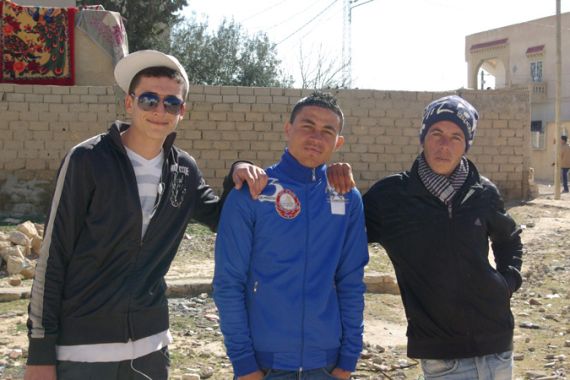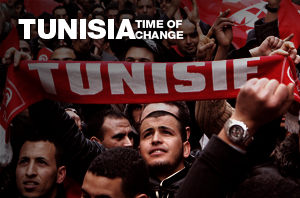The massacre behind the revolution
It was the deliberate slaying of protesters in Tunisia that turned a regional uprising into a nationwide revolution.

(Kasserine, Tunisia) – The earth around Kasserine is deep red, contrasting with the lush green vegetation further north. The terrain in the centre of the country becomes noticeably tougher and sparser, giving way to prickly pear cacti and olive trees.
The town of Kasserine lies near the Algerian border, in the shadow of Jebel ech Chambi, Tunisia’s highest peak. It was the blood that was spilt here over a weekend in January that transformed what had been a regional uprising into a genuinely nationwide movement.
It was the massacring of protesters in the centre of the country pushed the middle classes of Tunis into the streets.
The bloodshed lasted from January 8-12. Under pressure from protesters and the military, President Zine El Abidine Ben Ali was forced to call an end to the shooting of protesters.
“Enough firing of real bullets,” he said in his final speech on January 13. “I refuse to see new victims fall.”
Emboldened, the first mass protest on Avenue Habib Bourguiba took place in the capital the very next day.
Ben Ali’s speech had come too late to save his presidency, and the mood on the streets was unforgiving.
Breaking the threshold of fear
The protests began on December 17 in the town of Sidi Bouzid, about 75km to the east of Kasserine, after a young street seller named Mohamed Bouazizi set himself on fire.
By late December, the protests had spread to other towns in what is one of the poorest regions of the country, including Thala, Regueb, Menzel Bouzaiane and Kasserine.
“Mohamed Bouazizi broke the wall of fear. But the real centre of this revolution is Kasserine, and the neighbourhood of Ezzouhour by excellence,” Moez Bannani, a teacher at a local high school, said.
These protests became more regular and increased in size after students returned to school on January 3.
The fighting between protests and security forces intensified in Kasserine on January 7, after a local man set himself on fire, echoing Bouazizi’s act.
Local police had done little to disperse the protests. Then large numbers of anti-riot police known as the BOP (Brigades de l’Ordre Public) were brought in from other towns.
These units beat protesters and used teargas and rubber bullets against them.
Responding to the attacks, youths threw stones at police. Some hurled Molotov cocktails, but protests were mostly peaceful. There were no cases of demonstrators using firearms against security forces.
Then came a number of unidentified agents wearing different, slicker uniforms from either the BOP or the local police.
They used live bullets for the first time on January 8.
Amongst the first victims were Mohamed Mbarki, 17, and Slah Dachraoui, 19.
Like most of the shootings in Kasserine, Mbarki and Dachraoui were shot at the Monguela roundabout in the poor neighbourhood of Ezzouhour.
 |
| Follow Al Jazeera’s coverage of the turmoil in Tunisia |
The following day, four agents stormed the women’s hammam, a traditional sauna, on Monguela roundabout, where several women were relaxing with their young children.
Rebah Rebhi, the owner of the hammam, said the agents swore at the women and shot teargas into the hammam, blocking them from escaping. When the women, desperate for fresh air, opened a window, agents shot another teargas canister in through the opening, she said.
One of the agents who raided the hammam was a woman whose long blond hair flowed out from beneath her helmet. The other three were men, Gadbar said. All were dressed in black uniforms.
The terrified, semi-clothed women were only allowed to flee the gas-filled hammam after several minutes, coughing and choking. Rebhi’s elderly mother had to be hospitalised, as did some of the children.
Saber Rtibi, a 23-year-old who was about to move to France with his father, came to the defence of one of the fleeing women. The young man had just been to the grocery store when he saw his neighbour, Monia Omri, running up the street from the hammam with her young daughter, both coughing from the gas, according to Sourour Abdallah, an 18-year-old who was standing on the street that day.
The blond agent was chasing Omri and swearing at her. Rtibi tried to intervene, but the agent shot him in the stomach, killing him slowly.
After shooting Rtibi, the blond sniper removed her helmet, tossed her hair and blew kisses in the direction of his body, Abdallah and other witnesses present that day said.
Abdallah believes the agents gassed the hammam and insulted the women to provoke a reaction from the youth.
“They were doing that so that boys would come to protect their mothers, so they could shoot them,” Abdallah said.
Security forces also blocked the funeral procession for Mbarki that Sunday, and opened fire on the attendees at Monguela roundabout. Amongst those killed at the funeral was Walid Massoudi, who played football with Mbarki. The most brutal massacre of the Tunisian Uprising would take place the following day, at Massoudi’s own funeral.
The funeral massacre
Security forces tried to forbid locals from joining the funeral procession for Massoudi on January 10. Despite the warning, more than 200 people chose to accompany the young man’s coffin through the streets of Ezzouhour to the cemetery.
Sayhi Ahmed, a friend of Massoudi who took part in the procession, said they marched to mark the death of Massoudi, and to protest “for freedom, for rights, for human values and for jobs”.
Anti-riot police refused to allow the cortege to pass, however, blocking its route. Security forces launched teargas, while youths responded by throwing rocks.
Shortly after midday, at least five snipers standing on rooftops suddenly started firing on the procession, according to Ahmed. Most of them appeared to be women, he said, wearing helmets and black uniforms, automatic rifles in hand.
Amongst those killed was his friend Mohamed Khadraoui, 22, who was felled by a bullet in the head.
“He was killed in front of me,” Ahmed said. “They killed without pity.”
Khadraoui’s killer, standing on the roof of a cafe, gave the thumbs-up sign after hitting her target.
Nasr Ghodhbani’s cousin, Abdelkhader Ghodhbani, was also shot during the massacre. He was filming the snipers on his cellphone when he was targeted.
The 23-year-old ran into the courtyard of a house belonging to Saida Rebhi to try to escape the shooting, Rebhi said. But the agent pursued her target, broke down the door and gunned the young man down.
“The police targeted the youths who were leading the protests, those who were the most courageous, those who had a camera or a cellphone,” Nasr Ghodhbani said.
Compared to earlier shootings, in which security forces hit their targets mainly in the arms or legs, Ezzine Ben Abdallah, head of forensics at the Kasserine Hospital, said the shootings that took place on January 10 were clearly intended to kill.
“We were [in the days prior to January 10] reassured that they weren’t aiming at vital parts of the body. But they then changed strategy, brutally,” Abdallah said.
According to hospital records, eight people were killed in Kasserine that Monday.
At least 21 people were killed with live ammunition in Kasserine and Thala between January 8 and 12, according to Human Rights Watch.
Yakin Karmazi, a seven-month-old baby, died after her lungs were destroyed by teargas.
Intentionally lethal
International human rights organisations, including Amnesty International and Human Rights Watch, have condemned the Tunisian security forces’ “disproportionate use of force” against protesters and bystanders during the uprising.
Human Rights Watch said the evidence their team gathered in Kasserine suggested the security agents had breached Tunisian law.
The law states that security forces must give clear warning that they will use firearms, and that they should only fire in self-defence. Only when other means to disperse the crowd have been exhausted is shooting at protesters permissible.
Sayhi Ahmed said the security forces skipped usual techniques of crowd control.
“They went straight for the bullets,” he said.
Ezzine Ben Abdallah said there is clear evidence that the killings were deliberate.
Most of the victims were shot at a range of 50 to 100m, he said. Some of them were shot from behind. Issa Griri, shot during the funeral procession for Mbarki, was one of several people to be shot in back of the head. Others were shot as many as five times.
Most security forces did not just opt for live bullets rather than non-lethal rubber bullets. According to Ben Abdallah, they used expanding, “dum-dum” bullets, which are even more deadly than regular ammunition.
“It’s a type of bullet that explodes at the moment of contact,” he said. “When someone is wounded in the abdomen or the thorax, they can’t be saved.”
Mysterious militia
All witnesses in Kasserine agreed that the “snipers” responsible for most of the shootings were neither part of the regular police, or members of the BOP.
There has been speculation that they were members of the elite presidential guard. But according to a source with ties to the interior ministry, speaking on condition of anonymity, the shooters were members of a special militia that was organised independently from the presidential guard, although they were under the same command.
The militia was formed by General Ali Seriati, the former head of presidential security, Rafik Belhaj Kassim, the former interior minister, and Leila Ben Ali, the former First Lady.
They recruited members of the national police force and the presidential guard who had been discharged for serious infractions. These agents were given comfortable front positions as civil servants in various government ministries. To guarantee their loyalty, they received a second salary and other perks.
During the uprising, the agents were called up for duty. Some were used as snipers or to commit acts of vandalism, whilst others feigned pro-Ben Ali protests, such as the one on the night of Ben Ali’s speech.
“[The strategy] was aimed at creating chaos, but luckily it didn’t work,” the source said.
Regular police and the army were, overall, against shooting at protesters.
Soldiers arrived in Kasserine on January 8, but were not involved in the massacres. They were there strictly to protect banks, government buildings and the RCD offices, Adel Baccari, a local magistrate, said.
“From the beginning, [the army was] against shooting at people. That is what prevented an even higher death toll,” Baccari said.
The type of automatic rifles used by the snipers also suggests they were part of a separate entity.
Several people interview noted the fact that the snipers did not carry weapons from the Austrian arms manufacturer Steyr Mannlicher, unlike the rest of the Tunisian security forces.
“Steyrs aren’t precision weapons. These snipers were not using Steyrs,” Ahmed said.
After the massacres
Seriati and Kassim were arrested days after Ben Ali left the country. They were charged with plotting against state security and for “provoking disorder, murder and pillaging”.
The blond-haired shooter and her fellow militia members have, for now, disappeared back to wherever they came from.
The moment Ben Ali left, the people of Kasserine set about commemorating their dead. Monguela roundabout has become Martyrs’ Square. They have erected a memorial with their own hands.
Noomen Lobna, was one of a group of artists from Tunis who travelled to Kasserine Hospital last week with medical and food supplies in an act of solidarity with the locals.
“We’re here to thank them, because the revolution happened here while other Tunisians were still too scared to speak up,” Lobna said.
“These people were the first to become martyrs. We got our country back thanks to them.”
Follow Yasmine Ryan on Twitter @yasmineryan.